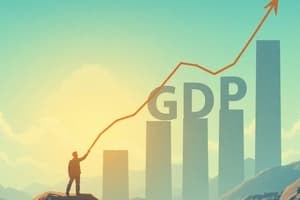Podcast
Questions and Answers
What does economic growth refer to?
What does economic growth refer to?
- Decrease in technological advancements
- Total monetary value of imported goods within an economy
- Long-term increase in an economy's output (correct)
- Short-term decrease in an economy's output
How is economic growth typically expressed?
How is economic growth typically expressed?
- By decreased productivity
- Through reduced labor investments
- As a percentage change over time (correct)
- As a decrease in living standards
What does Gross Domestic Product (GDP) measure?
What does Gross Domestic Product (GDP) measure?
- Healthcare services provided within a country
- Total value of imports within a country
- Monetary value of goods produced outside a country
- Aggregate economic activity within a country (correct)
How is GDP calculated?
How is GDP calculated?
What role does GDP play in macroeconomic analysis?
What role does GDP play in macroeconomic analysis?
Why is the GDP growth rate considered an essential indicator of economic health?
Why is the GDP growth rate considered an essential indicator of economic health?
What is the primary metric used to measure economic growth?
What is the primary metric used to measure economic growth?
How is GDP per capita calculated?
How is GDP per capita calculated?
What is the aim of governments and policymakers in managing economic growth?
What is the aim of governments and policymakers in managing economic growth?
Which policy involves government spending and taxation to steer economic growth?
Which policy involves government spending and taxation to steer economic growth?
What does a positive and stable growth rate of an economy indicate?
What does a positive and stable growth rate of an economy indicate?
Why is understanding economic growth and GDP important for students and professionals in economics?
Why is understanding economic growth and GDP important for students and professionals in economics?
Study Notes
Macroeconomics: Understanding Economic Growth and GDP
The realm of macroeconomics is where we explore the behaviors and trends of entire economies, rather than individual markets or firms. Two crucial topics in this field are economic growth and Gross Domestic Product (GDP).
Economic Growth
Economic growth refers to the long-term increase in an economy's output, or the total monetary value of goods and services produced within its borders in a specific time period. This increase is typically expressed as a percentage change over time.
Growth can be attributed to a variety of factors such as increased productivity, labor, investment, or technological advancements. When economic growth is positive and sustained over time, living standards can improve, unemployment may decrease, and nations may experience an enhanced quality of life.
Gross Domestic Product (GDP)
GDP is a measure of aggregate economic activity. It is calculated by adding the total monetary value of final goods and services produced within a country's borders in a specific time period.
GDP plays a central role in macroeconomic analysis. It helps us determine an economy's size, assess its health, and monitor changes in economic activity. Since GDP is a quantifiable measure, it allows economists to compare economic performance across countries and over time.
GDP Growth Rate
The rate at which GDP increases or decreases over time is an essential indicator of economic health. It reflects the pace at which an economy's output is expanding, or in a downturn, contracting.
GDP growth rates are influenced by a wide range of factors, including demand, supply, productivity, and investment. An economy with a positive and stable growth rate is generally considered to be healthy, conducive to job creation, and capable of sustaining a higher standard of living for its population.
Measuring Economic Growth
The primary metrics used to measure economic growth are real GDP (GDP adjusted for inflation) and nominal GDP (GDP without adjusting for inflation). Economists also calculate GDP per capita (the average GDP per person) to capture the impact of growth on the standard of living.
Economic Growth and Policies
Governments and policymakers actively seek to manage economic growth, often with the aim of achieving a balance between high levels of growth and low levels of unemployment, inflation, and economic instability. Some of the tools used to steer economic growth include fiscal policy (government spending and taxation), monetary policy (interest rate management and money supply control), and structural policy (investment in education, infrastructure, and innovation).
Understanding economic growth and GDP is vital for both students and professionals in the field of economics. These concepts help us appreciate the complexities of our global economy and the various forces that shape it.
Studying That Suits You
Use AI to generate personalized quizzes and flashcards to suit your learning preferences.
Description
Test your knowledge on economic growth, GDP, and their impacts on national economies in this Macroeconomics quiz. Explore the concepts of GDP growth rate, measuring economic growth, and economic policies for sustainable development.




